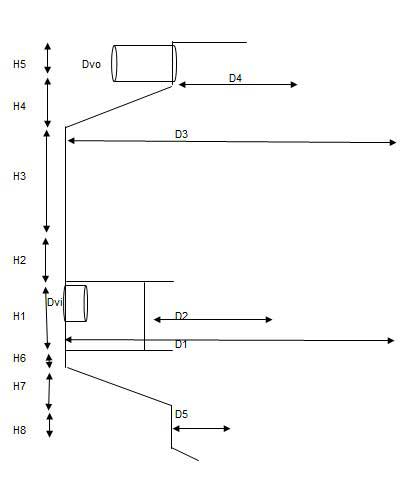In this session discuss about Vacuum Pan design criteria for crystallization process in sugar factory.
Vacuum Pan Design Aspects in Sugar Factory | Sugarprocesstech
The following factors which are playing an important role in design aspect of a vacuum pan.
a) Incoming
b) Outgoing
c) Internal
d) External
a) Incoming
1. Heating medium (Vapour/Steam) – Steady flow and uniform quality of vapour
2. Footing / Seed material – Uniform grain size and predetermined ratio grain with liquor.
3. Liquor ( Syrup / molasses ) – Uniform composition and flow rate of feed
4. Moment Water – Constant Temperature and flow rate.
5. Vacuum of the Pan – Steady and uniform.
b) Outgoing
1. Massecuite – Uniform consistency, Purity and grain size.
2. Condensate flow – Complete withdrawal of condensate for Smooth flow
3. Non-condensable gases – Complete removal of NCG without stagnancy
c) Internal
1. Massecuite head (Hydro static head) – As minimum as possible for better circulation and boiling point rise of massecuite
2. Boiling point rise – Minimum fluctuation
3. Circulation of massecuite – Velocity should be as high as possible
4. Temperature of the massecuite – Steady and uniform.
e) External
1. Head loss – Constant and uniform pan temperature
2. Injection water – Flow rate and temperature condition should be uniform
Now Discuss one by one major design considerations of vacuum pan
Graining Volume of the batch pan ( Go through the below link)
The Concept of Graining Volume
Heating surface to ratio of the pan ( S/V ratio)
S/V ratio is important factor in the design and performance of vacuum pan. The heating surface is expressed in square meter and working volume expressed in cubic meter.
So the unit of S/V ratio becomes m2/m3.
This ratio is mainly depends on the heating medium and type of the pan.
According to present scenario, 2nd bleed or 3nd bleed or 4th bleed vapours is used as a heating medium for pan boiling.
For batch pan the S/V ratio will be in the range of 6.5 to 6.8 m2/m3
For continuous pan the S/V ratio will be in the range of 9.5 to 10.5 m2/m3
Hydrostatic head or Hydrostatic pressure
Please go through the below link
The height of the strike
The massecuite circulation will be slow down while massecuite reaching level 1000 mm above the top tube plate.
Generally, the highest massecuite level above top tube plate is kept around 1000 mm to 1200 mm in batch pan and 300mm to 500 mm in continuous pans without using any mechanical circulator. While using the mechanical circulators, it will be increased by 200 to 300 mm height
Bottom Cone
The bottom of the pan generally takes the form of a truncated cone, but a segment of a sphere, or even a torus may be followed.
This part of the pan is situated at the bottom of the pan below the calendria making an angle of 170 to 250 with the extended portion of the vertical side wall of the calendria.
The extended portion is of about 150mm to 200mm.
This is to facilitate the repairs / replacement of the end tubes of the calendria. It is advantageous for graining volume that these angles should be small but, for rapid flow of the massecuite at the moment of discharge, an angle of less than 17° will not generally be used.
Generally, cone angle is 180 to 200 is the value while considering all advantages and disadvantages
Downtake Diameter
The downtake diameter is generally not less than 0.4 times the pan diameter, unless a stirrer is fitted. A smaller diameter has been shown to restrict circulation.
Circulation ratio is one of the important criteria for estimating the downtake diameter.
Ideally this should be less than 2.5 to obtain a pan with good circulation, although a number of pans that have circulation ratio values up to 2.8 have given reasonable results.
Tubes
Generally the tubes are made up of Stainless steel. The diameter of the tube is 100 mm and length of tubes varies from 700-1500 mm.
Stainless steel for tubes is generally AISI 304 grade (18% Cr + 8% Ni).
The tubes are generally, 100 mm diameter and installed on triangular pitch. The legment having 16 mm.
Tube diameters may be for low grade and smaller for high grade massecuites.
Boiling Point Rise
The boiling point rise or ‘boiling point elevation’ is defined as the temperature difference between the boiling point of the boiling massecuite at a given absolute pressure and the boiling point of water at the same absolute pressure.
i.e Difference between the temperature of a boiling sugar solution and the temperature of boiling pure water, both measured at the same pressure.
The boiling point of the massecuite depended on
1. Brix of the material (Density or Dissolved solids of material
2. Height of the massecuite above the calendria of a pan. ( Strike height)
3. Circulation of massecuite. (Mechanical and Natural circulation)
Various heights and dia of the batch vacuum pan for design aspects
( Note: These measurements will be given a approximate values in design of vacuum pan)
Dia of Vacuum pan
D1 – Calendria shell dia ( 1.21 P √N – P = Pitch of the tube & Number of tubes)
D2- Down take dia (0.4D1)
D3 – Vapour body dia = D1
D4 – Vapour dome dia (1.8 to 2 Dvo)
D5 – Discharge dia
Dvo – Vapour O/L dia
Dvi – Vapour I/L dia
Height of the vacuum pan
H1 – Calendria shell height ( Depends on tube height)
H2 – Strik level height from the top tube plate ( Depends on graining volume of pan)
H3 – Vapour space above the strik level (1200mm to 1500 mm )
H4 – (D3-D4) x Tan ∅ /2 ( ∅ = 180 to 200)
H5 – Height of the vapour dome (1.5 to 1.75 Dvo)
H6 – Bottom ring ( 150mm to 200 mm)
H7 = (D1-D5) x Tan ∝ /2 ( ∝ = 180 to 200)
H8 – 150mm to 200mm
Steam Entry
For pans with central downtake, it is preferable to distribute the steam through several entries placed around the calandira. The quantity of steam surging against the outer tubes immediately in front of the steam entry produces a very rapid circulation at that point at the beginning of the strike at the expenses of other zones of the Calandria. While at the end of the strike, this zone near the steam entry may produce false grain.
For this point of view it is preferable to provide each steam entry with a conical baffle to distribute the steam and avoid direct over heating of massecuite. For large capacities pans shall be provided two steam entry points.
Condensate Removal
Condensate water is removed by either inverted siphon or sealing mond. The sizing of condensate shall be calculated on the basis of velocity of condensate having 1 m/sec.
Number of condensate points will be choosen on the basis of calendria dia meter
Non Condenssible gases (NCG) Removal
Adequate arrangements for the removal of condensate and incondensable gases must be made.
Generally non-condensable gasses are released by number of perforated pipes inside calandria and connected through main line and vented outside the pan. The total cross section are of the all NCG connection shall be required 1 cm2 area for 10 m2 heating surface of vacuum pan.
Sight Glasses
The batch vacuum pans are equipped with 4 – 6 sight glasses at different height from front side and one sight glass from backside at the top level so as to facilitate easy supervision. For continuous pan equipped with sight glasses for each compartment.
Design of 80 MT capacity Batch Pan
Please go through the link Click Here
Related Articles:
Three and half massecuite boiling material balance calculation
Sugar Factory Material Balance Calculation for three massecuite Boiling
Vertical Crystallizer Concepts in Sugar Plant | Mono Vertical Crystallizer
Cooling and reheating Process of low grade (B & C) massecuites
Sugar Seed Slurry Requirement Calculation for B and C massecuite
Types of graining techniques in sugar industry pan boiling
Formulas for Sugar Industry boiling house stock calculation
Specific speed of a centrifugal pump | Formula for Pump Power Calculation







14 thoughts on “Vacuum Pan in Sugar Industry | Vacuum Pan Design Criteria | Sugar Tech”
Uday Pratap Singh
(May 14, 2019 - 9:31 am)Quantiple set -Exhaust pres.0.95 Kg/Cm2 ,first body calendria exhaust temp.128 degree centigrate and last body vacuum 25.5 inch.and pressure corresponding to first body calendria temp. 1,2,3,4 and last body vapour temp.
siva alluri
(May 22, 2019 - 2:56 pm)Please go through the below link
https://www.sugarprocesstech.com/pressure-drop-calculation/
Shankar shigihalli
(June 29, 2020 - 2:51 pm)Please may i know the design calculations of centrifugal type entrainment seperator and umbrella type
siva alluri
(July 1, 2020 - 1:44 pm)Ok we will provide that details soon
Vijay Yadav
(August 18, 2021 - 6:19 am)S/V RATIO OF CONTINUOUS PAN CALCULATION
siva alluri
(September 2, 2021 - 8:28 am)10 to 10.5
VIMAL VERMA
(August 24, 2021 - 6:36 am)How to calculate continous pan capacity
siva alluri
(September 2, 2021 - 8:23 am)Are you asking about required capacity of continuous pan as per the crushing rate
bharat kshirsagar
(September 18, 2021 - 3:05 pm)Pan cache valve all Tipe info please
Battch pan all tips (low Head, high Head pans)
Bharat
(August 31, 2022 - 3:14 pm)I nerd cache valve design for pan body
M.S.Sonar
(March 17, 2024 - 4:06 am)Sir,
Please let me know complete calculation of continuous pans of different length of tubes & compartments.
siva alluri
(April 22, 2024 - 5:33 am)we will provide soon
Amunavi m lisiebi
(June 19, 2024 - 6:42 am)Please please send me those notes of boiled vuccum pans sugar, am at kakamega, Kenya
Siva Alluri
(June 24, 2024 - 2:08 pm)Please follow the below references
https://www.sugarprocesstech.com/vacuum-pan-sugar/
https://www.sugarprocesstech.com/pan-section-capacity/